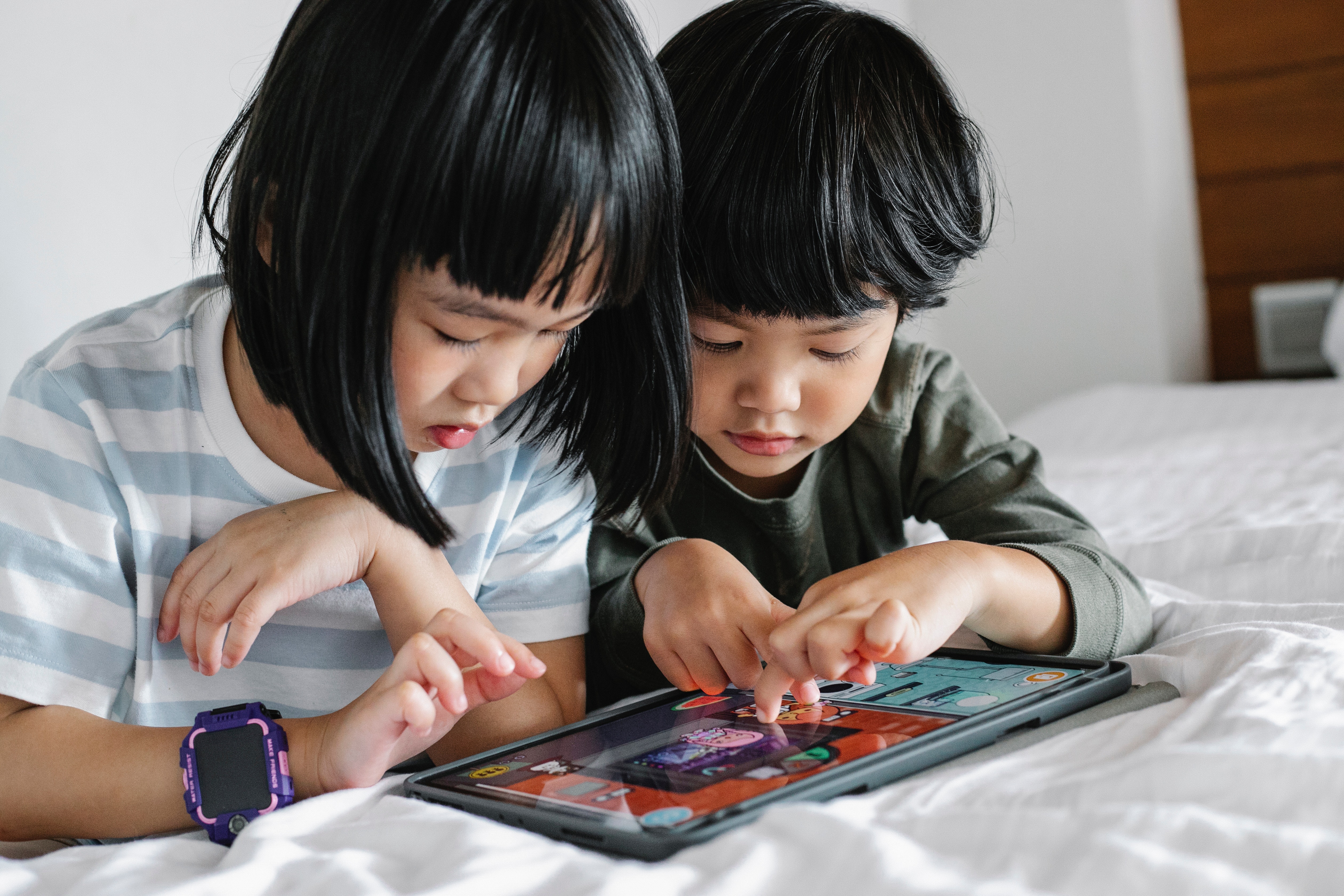.jpeg)
Matthew G Scott
Matthew is a father of 3 and holds a Bachelor of Education from Melbourne University, a Masters of Education from Monash University, and a Graduate Diploma of Psychology from Monash University.
As the world moves deeper into the digital realm with home-based learning with the onset of the pandemic, we use more time on our devices and on digital services than ever before. With a few clicks propelled by AI and machine learning your child may potentially be in a dangerous space, where you would not want them to be. As we bring awareness and attention to the digital world, we find out more through the eyes and mind of our EtonHouse educator and parent, Matthew Scott, Principal of Middleton International School.
 At heart, I’m an optimist. Honestly, I am. However, the ‘eyes down’ movement disturb me. As we edge closer to the middle of 2021, one of the more noticeable trends occurring in adolescents is an unhealthy relationship with their digital devices (Burns & Gottschalk, 2020). A simple manifestation of ‘eyes down’ can be seen at the end of the school day.
At heart, I’m an optimist. Honestly, I am. However, the ‘eyes down’ movement disturb me. As we edge closer to the middle of 2021, one of the more noticeable trends occurring in adolescents is an unhealthy relationship with their digital devices (Burns & Gottschalk, 2020). A simple manifestation of ‘eyes down’ can be seen at the end of the school day.
During the day students are engaged, open-minded and alert. They navigate complex academic subjects and sometimes more complex social situations with eyes up, developing soft skills such as observation, empathy and other prosocial behaviours. However, once the end of the day bells rings, the gates open and strange phenomena occur. Students turn onto the footpath and then each one slips their hand into their pocket and picks up their phone. From there on it’s an eye down walk home. They leave the physical world and enter a strange blended universe, a world that is both digital and physical. Now, I agree this sounds a little dramatic.
However, it’s also anecdotally true and underpins the tensions young learners are facing in developing balanced, mindful relationships with technology.

The rise of technology use has led to growing concerns amongst parents, teachers and learners about how to best manage devices (Burns & Gottschalk, 2020). Traditionally, schools would have run cyber safe programs and worked their way through a digital citizenship curriculum. Whilst these interventions have been useful, they have not addressed key psychological tensions or the addictive nature of devices. The need for adoption is no longer a slow plod but rather a frenetic sprint.
As a parent and leader, at times, this scares me. I was privileged to grow up in a generation where there was limited video and photographic evidence of my parachute pants and double denim (& other fashion faux pas) our children are not this lucky. Their teen years, their joys and their mistakes will most likely be filmed, commented on and shared with the possibility of being stored forever.
This paradigm shift changes the way we think and act in a very digital world. Technology is now embedded into the very fabric of our lives and leads me to dwell on the notion that as cognitive requirements to successfully use technology increase, the need to explicitly teach our children how to emotionally and psychologically flourish in this context is vital.
As we shift from banning or blaming technology and embrace the tension of ‘what does it mean to flourish in a digitally rich world’? We begin to see this challenge of digital wellbeing in a more constructive and optimistic light.
Google (2020) ironically, takes the stance that digital wellbeing is about relationships. Ideally one built with us in the driving seat. 'Digital wellbeing is about crafting and maintaining a healthy relationship with technology. It’s about how technology serves us and moves us towards our goals, rather than distracting us, interrupting us or getting in the way. Being in control of technology enables us to use its full potential and gain all the benefits of it'.
Our focus needs to shift gears from ‘control’ (over devices, apps and sites) to a focus on ‘behaviours and choices’. A shift to carefully consider the psychological impacts and skills that learners require to navigate this context. This is where the impact of mindfulness can support our learners to make discerning choices when using technology.
Mindfulness pioneer Jon-Kabat Zinn defines mindfulness as ‘paying attention in a particular way on purpose, in the present moment and non-judgmentally (Kabat-Zinn, 2012). Through the strategic and intentional development of mindfulness-based practices, we can support our learners to increase their capacities to make wise decisions. To further expand on this, we can use the 3As of mindfulness developed by the Centre for Mindfulness in Singapore.
Fig 1. The Three As of Mindfulness
Attention
One of the benefits of sustained mindfulness practices is the development of the individual's ability to pay attention in the present moment. Through mindfulness, learners develop their ability to focus on key ideas, thoughts and actions. They become more intentional and discerning when making decisions (Smalley & Winston, 2010). As William James once famously said ‘The faculty of voluntarily bringing back a wandering attention, over and over again, is the very root of judgement, character & will. An education which should improve this faculty would be an education par excellence ’.
The practice of mindful breathing is one technique that can develop attention muscles. Mindful breathing allows students an opportunity to focus on one object (their breath) for a period of time. For example, students may draw their attention to their anchor spot (where they notice their breath the most) and focus on the sensation of oxygen moving in and out of their body.
When they become distracted, they can gently return to the sensation of the breath to continue. The use of cognitive reminders can be applied when they begin to lose focus. Phrases such as, ‘thinking, thinking', can act as a reminder to return to the breath. By gradually building up stamina in this area, learners can develop pathways to remain focussed and attentive in whatever they decide to focus on, both online and face to face.
Awareness
The second ‘A’ of mindfulness is ‘awareness’. Through mindfulness practices, learners develop their ability to increase their emotional and physical awareness (Siegal, 2010). This can be particularly powerful for adolescents. Imagine being faced with a flood of social media data, fake news stories, home learning tasks, all whilst going through puberty! Leveraging key mindfulness techniques, such as self-curiosity can support students to examine their emotions and choose wise responses when online. ‘Open awareness is about accepting what is and not being swept up by those judging activities’ (Siegal, 2010). Through self-curiosity, learners can become mindful of how technology makes them feel? Does it have an overall positive or negative impact on their wellbeing? An example of a self-curiosity check-in is below:
Self Curiosity Check-In:
Before, during and after the use of devices, ask your child:
- What emotions are you feeling? What makes you say that?
- Where is the emotion present in my body? How long did it last?
- Why am I feeling this? Are there other perspectives that I could consider?
- In what ways does technology make me feel safe?
- Has this experience made me a better person? Have I acted in accordance with my personal values?
Based on the responses, and over time, students will learn to be more reflective and more aware of the emotions (both positive and negative) that they experience whilst navigating the digital world. These prompts can provide us with valuable insight into the behavioural motivations behind technology use in our students and children.
Acceptance Before Response
The final ‘A’ of mindfulness stands for ‘acceptance before response’. Dating back to Frankl’s (1946) harrowing experiences of WW2, the tenant here is that between stimulus and response, we have a choice. It is in this space, freedom exists. As learners who are immersed in a digital world, it can be tempting to default to a reactionary stance. Smalley & Winston (2010), state that one of the key drivers behind mindfulness is supporting practitioners to shift from a reactive state and move to a calm response trait (Smalley & Winston, 2010). ‘By slowing down your mind and developing awareness, mindfulness practice will help you work more skillfully with your thoughts, feelings and reactions, and create a “gap” where genuine choice and freedom arise’ (Crisp, 2006)
For students, this is a particularly crucial pivot point when using technology. If we can develop strong cognitive practices to accept things as they are (whether positive or negative) and then choose a wise response, we will be on our way to developing healthier, more sustainable relationships with technology. One tool to support this is the STOP acronym from Smalley & Winston (2010)
STOP Tool For Developing Discerning Decision Making - Adapted for a digital context.
S= Stop. Pause your actions immediately. Step away from the screen. Put down the phone.
T= Take a few deep breaths. Inhale a few, slow deep breaths. This will support your brain to shift from its reactionary stance in the amygdala and to enter a more logical, calm state in the prefrontal cortex
O= Observe. Take a minute to carefully approach your emotions from a position of curiosity. Why am I feeling this way? What emotions have this post/content/message made me feel? Do I need to share this with an adult?
P= Proceed. Taking into account your reflections and thoughts proceed with intentional, wise decisions that align with your personal values. Seek help if you are unsure.
Through the development of mindfulness practices, we can intentionally support our learners to successfully navigate the demands of an increasingly digital world. Now, I am not suggesting that mindfulness is a silver bullet that will eliminate poor decision making and the negative impacts that can sometimes be associated with online use. However, I do think the need for our students to develop greater awareness and attention whilst online is a crucial challenge facing education and parents in 2021. With sustained practice, and through rich conversations with key stakeholders (schools and families), I do believe that we can support our youth to flourish in the information age.

Listen to our podcasts on mindfulness:

